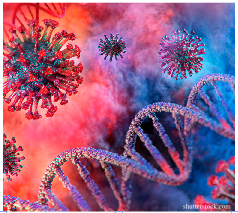“Although many of us might not have heard of coronaviruses before 2019, these viruses are not new to the world. They belong to a large family of hundreds of viruses that have been on scientist’s radar for a long time. Most of these viruses reside in animal reservoirs like pigs, camels, bats, or cats. Despite the world’s familiarity with different types of coronaviruses, COVID-19 is known as a “novel” coronavirus. This means that, although this virus has existed in animals for some time, it has only recently been identified through an animal-to-human transition.” Coronaviruses New to Humanity But Not New To the World- Linda Kesselring https://scholarblogs.emory.edu/techtransfer/2020/11/coronaviruses-new-to-humanity-but-not-new-to-the-world/
For over two years we have been inundated with talk and computer generated images about and of coronaviruses, “novel coronaviruses” pandemics, epidemics and other health related jargon. This assault has created anxiety, panic and hysteria mainly because COVID has been used to batter our confidence and make us think we are in the midst of a global plague. We are not!
What we know is that this “novel coronavirus” is called novel because it did not originally infect humans that it probably came from a species cross over; meaning it “jumped” from an animal (probably a bat) to humans. Most virologists will tell you this is a truly rare phenomenon. “Because every virus has evolved to target a particular species, it’s rare for a virus to be able to jump to another species. When this does happen, it’s by chance, and it usually requires a large amount of contact with the virus. Initially, the virus is usually not well-suited to the new host and doesn’t spread easily. Over time, however, it can evolve in the new host to produce variants that are better adapted. When viruses jump to a new host, a process called zoonosis, they often cause more severe disease. This is because viruses and their initial hosts have evolved together, and so the species has had time to build up resistance. A new host species, on the other hand, might not have evolved the ability to tackle the virus. For example, when we come into contact with bats and their viruses, we may develop rabies or Ebola virus disease, while the bats themselves are less affected.” How do viruses jump from animals to humans? Katherine Arden
https://www.sciencefocus.com/the-human-body/how-do-viruses-jump-from-animals-to-humans/. The emphasis underlining is mine!
Our bodies have an amazingly sophisticated immune system designed to protect us from the billions of pathogens, microbes, bacteria and germs we come into contact with every day. For a coronavirus from an animal to infect a human several things have to happen, “The first stages of an infection happen when a virus gets past our physical barriers of skin and mucus, and enters a suitable cell. Once inside, a virus can take over the cell, forcing the cell to make many copies of the virus (replicate), which damages the cell and sometimes kills it. The newly-made viruses are released to find a new cell. We get ill when a virus has established an infection in many cells, and our body’s normal functioning changes. Viruses often infect specific places in our bodies, which is where we feel their effect. Rhinoviruses infect our upper airways behind our nose, and we respond with snot and sneezes: a common cold. The coronavirus that emerged in 2019 (called SARS-CoV-2) infects our lower airways, including our lungs, leading to pneumonia. Our body fights viruses by creating an inflammatory response and calling in specialist cells from our tissues and organs. Some of these cells can make antibodies against the virus, some destroy the infected cells, and others build a memory of the virus for next time. Some of the things that make us feel ill – snot, fever and swollen lymph nodes, for example – are due to our body’s battle to get rid of the virus, not because of the virus itself.” How do viruses make us ill? Katherine Arden https://www.sciencefocus.com/the-human-body/how-do-viruses-make-us-ill/
In the world of germ and biological warfare there is a thing called gain of function research, I’ve written about this before. Gain of function (GOF or GoFR) is defined as: “‘Gain-of-function’ is the euphemism for biological research aimed at increasing the virulence and lethality of pathogens and viruses. GoF research is government funded; its focus is on enhancing the pathogens’ ability to infect different species and to increase their deadly impact as airborne pathogens and viruses. Ostensibly, GoF research is conducted for biodefense purposes. These experiments, however, are extremely dangerous. Those deadly science-enhanced pathogens can, and do escape into the community where they infect and kill people. What’s more, this line of research can be used for biological warfare.” What is Gain of Function Research & Who is at High Risk? https://ahrp.org/what-is-gain-of-function-research-who-is-at-high-risk/
This is what all the brouhaha about Anthony Fauci funding GoF research in the U.S. and China is all about. SARS COV-2 was one of several corona viruses that are not endemic to humans, that why they called it a novel virus! The other thing we need to ponder is the reason most corona viruses are not amenable to vaccines is because in their natural state (or when they are not the result of GoFR) they readily mutate so a vaccine can’t keep up with them. This is why you are asked to get a flu shot every year because the flu virus is a corona virus!
That being said whether SARS-COV 2 is natural or the result of GoFR it is still a corona virus subject to constant mutation which means these COVID injections being mandated aren’t the be and end all for stopping its spread; more food for thought.
More food for thought
Reading Time: 4 minutes


